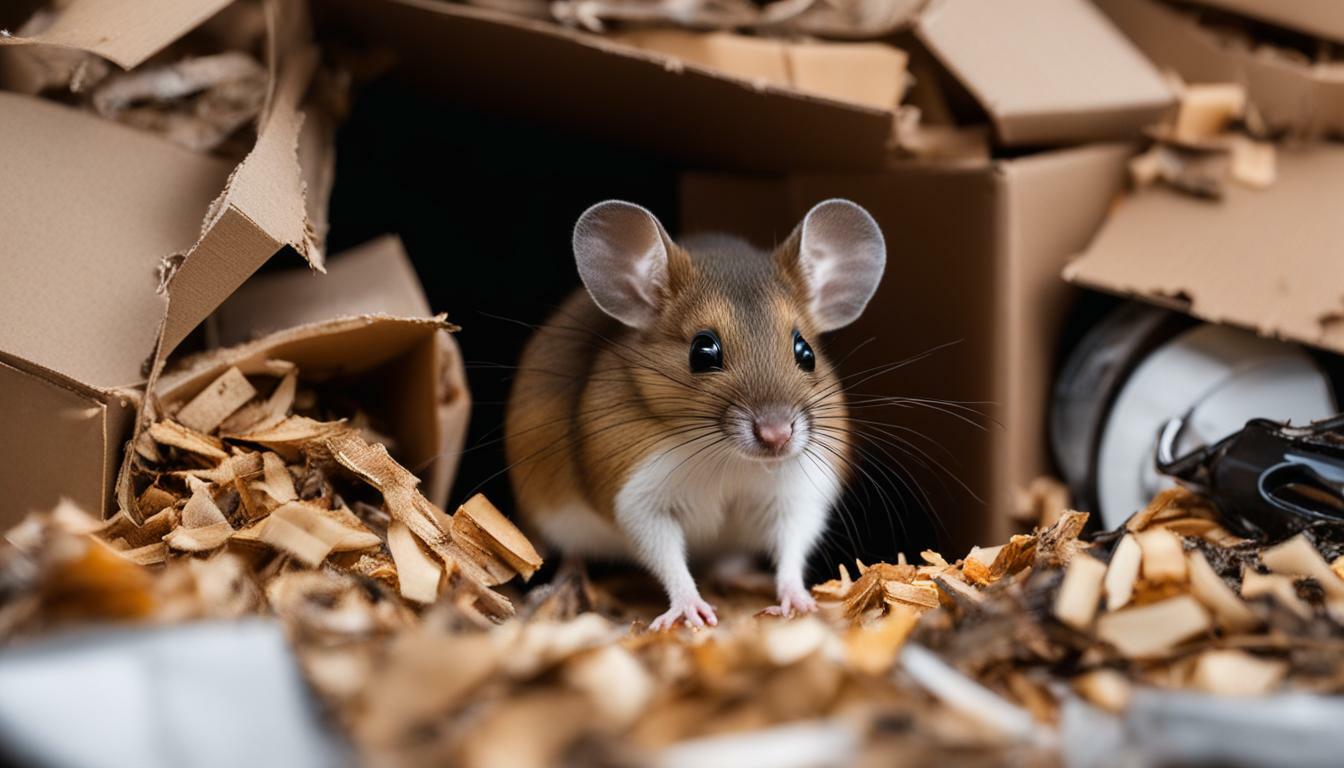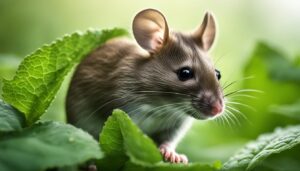Deer mice can be potentially dangerous due to the health risks they carry and the damage they can cause. These small rodents are carriers of lethal diseases, including the Hantavirus, which can pose serious health hazards to humans. Additionally, deer mice have the ability to cause severe structural damage to homes and buildings, making them a nuisance that should not be taken lightly.
- Deer mice are carriers of the Hantavirus and other diseases, posing health risks to humans.
- They can cause significant damage to homes and buildings, requiring preventive measures.
- Deer mice are nocturnal creatures and can be found in forests, crops, and woodlands.
- Signs of a deer mouse infestation include scurrying sounds, droppings, gnaw marks, and nests.
- Preventive measures include sealing openings, using traps, and seeking professional pest control services.
Diseases Carried by Deer Mice
Deer mice are carriers of various diseases, including the deadly Hantavirus. These small rodents can transmit diseases to humans through direct contact with their urine, droppings, or saliva, as well as through inhalation of contaminated particles in the air. One of the most concerning diseases associated with deer mice is the Hantavirus Pulmonary Syndrome (HPS), which can lead to severe respiratory distress and, in some cases, death.
The Hantavirus is primarily spread to humans when they come into contact with deer mice or their excrements. It is important to note that the virus does not typically cause illness in the mice themselves, allowing them to carry and transmit it without showing visible signs of infection. Therefore, it is crucial to take precautions when dealing with deer mice or suspected infestations to minimize the risk of disease transmission.
Other diseases carried by deer mice include Lyme disease, tick-borne relapsing fever, and salmonellosis. Symptoms of these diseases can range from mild to severe and may include fever, fatigue, muscle aches, headache, and gastrointestinal issues. Prompt medical attention should be sought if any symptoms occur after potential exposure to deer mice or their habitats.
| Disease | Transmission | Symptoms |
|---|---|---|
| Hantavirus Pulmonary Syndrome | Inhalation or direct contact with infected mice or their excrements | Severe respiratory distress, fever, muscle aches, fatigue |
| Lyme Disease | Bite from infected ticks that feed on deer mice | Fever, fatigue, joint pain, headache, skin rash |
| Tick-Borne Relapsing Fever | Bite from infected ticks that feed on deer mice | Fever, chills, headache, muscle and joint aches |
| Salmonellosis | Ingestion of food or water contaminated with deer mouse feces | Diarrhea, abdominal pain, fever, vomiting |
It is crucial to take preventive measures to reduce the risk of exposure to diseases carried by deer mice. This includes sealing openings and gaps in your home to prevent their entry, practicing proper hygiene, and implementing effective rodent control methods. If you suspect a deer mouse infestation, it is recommended to seek professional pest control services to safely and effectively eliminate the problem.

Detecting a deer mouse infestation is crucial as it poses significant health risks to humans. These small rodents are carriers of lethal diseases, including the Hantavirus, which can have severe health implications. Understanding the symptoms of a deer mouse infestation is essential in order to take prompt action and protect your health and well-being.
One of the most common signs of a deer mouse infestation is the presence of scurrying sounds, especially at night, as these creatures are nocturnal by nature. If you notice any unexplained noises, it’s important to investigate further. Another indicator is the sight of droppings. Deer mouse droppings are small and pellet-like, often found in areas where they nest or feed. These droppings can pose a health risk if inhaled or ingested.
Gnaw marks are another telltale sign of a deer mouse infestation. These rodents have sharp teeth that they use to chew through various materials, including wood, wires, and insulation. If you come across chewed wires or damaged woodwork, it could indicate an infestation. Additionally, finding nests made of shredded materials, such as paper or fabric, is another sign that deer mice have taken up residence in your home or building.
To summarize, symptoms of a deer mouse infestation include scurrying sounds, droppings, gnaw marks, and nests. If you notice any of these signs, it’s important to address the infestation promptly to minimize the health risks associated with these rodents.
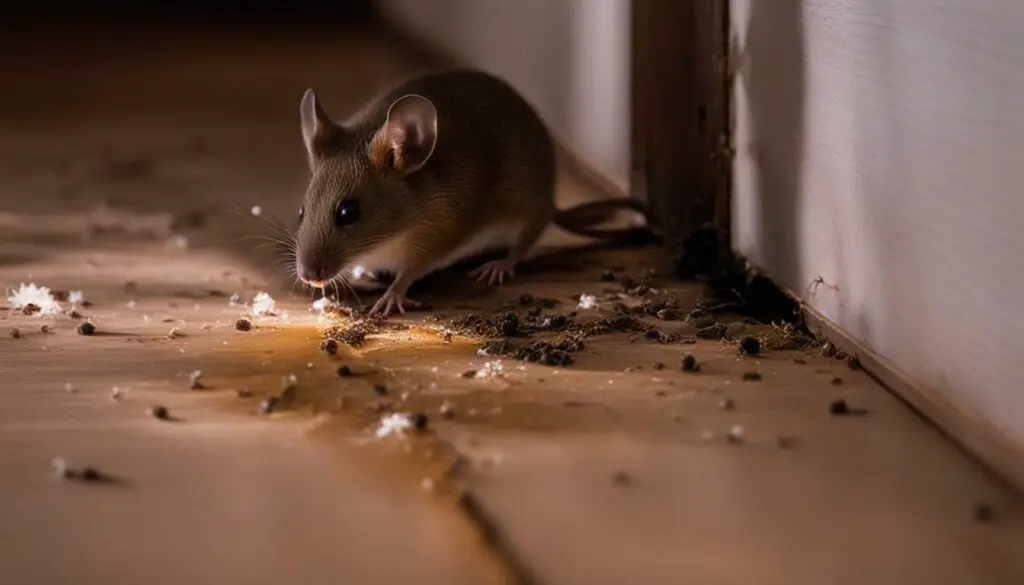
| Symptoms of Deer Mouse Infestation: | Action: |
|---|---|
| Scurrying sounds | Investigate the source of the noise and take appropriate measures to address the infestation. |
| Droppings | Wear protective gloves and a mask while cleaning up and dispose of the droppings properly. |
| Gnaw marks | Inspect the affected areas for any damage and consider sealing any entry points to prevent further infestation. |
| Nests | Remove and dispose of the nests safely. Consider contacting professional pest control services to address the infestation effectively. |
Structural Damage Caused by Deer Mice
Deer mice can wreak havoc on homes and buildings, causing extensive damage. These small rodents have a penchant for gnawing on various materials, including wood, insulation, and electrical wiring. Their constant chewing can weaken the structural integrity of a property, leading to potential safety hazards and costly repairs.
One of the most concerning aspects is their tendency to chew on electrical wiring. This behavior not only puts the building at risk of electrical malfunctions and fires but also poses a significant danger to its occupants. Additionally, deer mice can create entry points by gnawing through walls, vents, and other openings, further compromising the structure.
It is essential to address a deer mouse infestation promptly to minimize the extent of damage. Seeking professional pest control services can help eliminate these rodents and prevent further destruction. Moreover, taking preventive measures like sealing openings and gaps in the home can reduce the risk of future infestations and the accompanying structural damage.
Deer Mouse-Related Structural Damage
| Damage | Description |
|---|---|
| Electrical Issues | Gnawing on wiring can lead to short circuits, power outages, and fire hazards. |
| Weakened Wood | Chewing on wooden beams, furniture, and fixtures can compromise their strength. |
| Insulation Damage | Tearing and soiling insulation reduces its effectiveness and increases energy loss. |
| Structural Compromise | Gnawing through walls and other materials weakens the structural integrity of the property. |
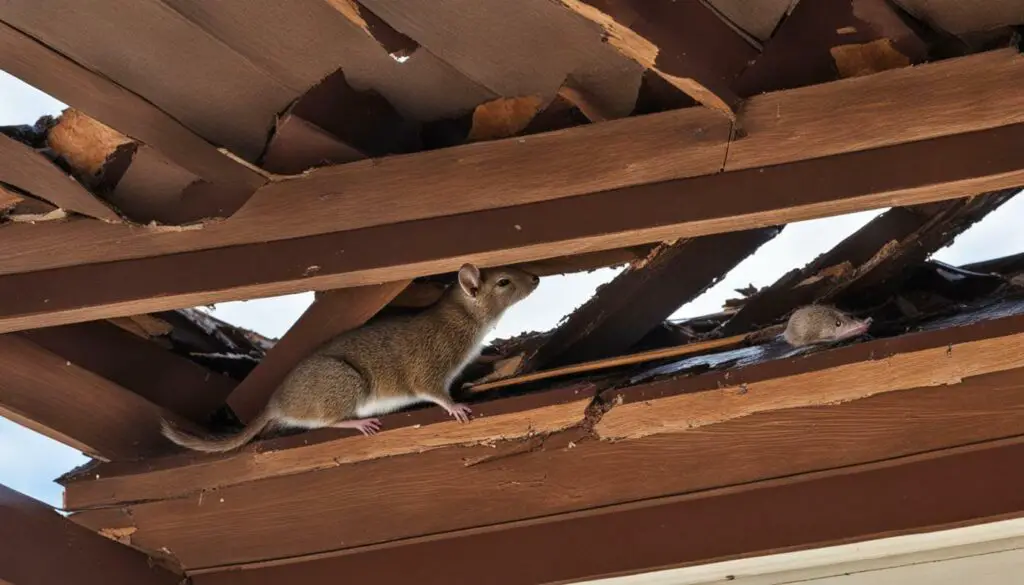
Habits and Habitat of Deer Mice
Deer mice are nocturnal and thrive in forested areas, crops, and woodlands. They are well-adapted to these environments, using their keen senses to navigate through the dense undergrowth and find food sources. These small rodents are excellent climbers and can easily scale trees and shrubs in search of seeds, fruits, and insects.
While deer mice primarily inhabit outdoor natural areas, they may venture into homes and buildings if they find a readily available food source. This can happen when crops are nearby or if there are open doors or windows that offer easy access. Once inside, deer mice can cause considerable damage by gnawing on wood, wires, and insulation, and even contaminating food supplies with their droppings.
| Preferred Habitats | Preferred Foods |
|---|---|
| Forested areas | Seeds |
| Crops | Fruits |
| Woodlands | Insects |
Adapting to Human Environments
Deer mice are resourceful creatures and can adapt to human environments if necessary. They may seek shelter in attics, crawl spaces, or basements, where they can build nests from shredded materials and reproduce rapidly. It’s important to be aware of their presence and take proactive measures to prevent infestations before they become a serious problem.
To effectively control deer mice, it’s crucial to understand their habits, preferred habitats, and potential entry points into your home. By sealing openings and gaps, removing potential food sources, and utilizing traps and rodent control products, you can greatly reduce the risk of a deer mouse infestation.
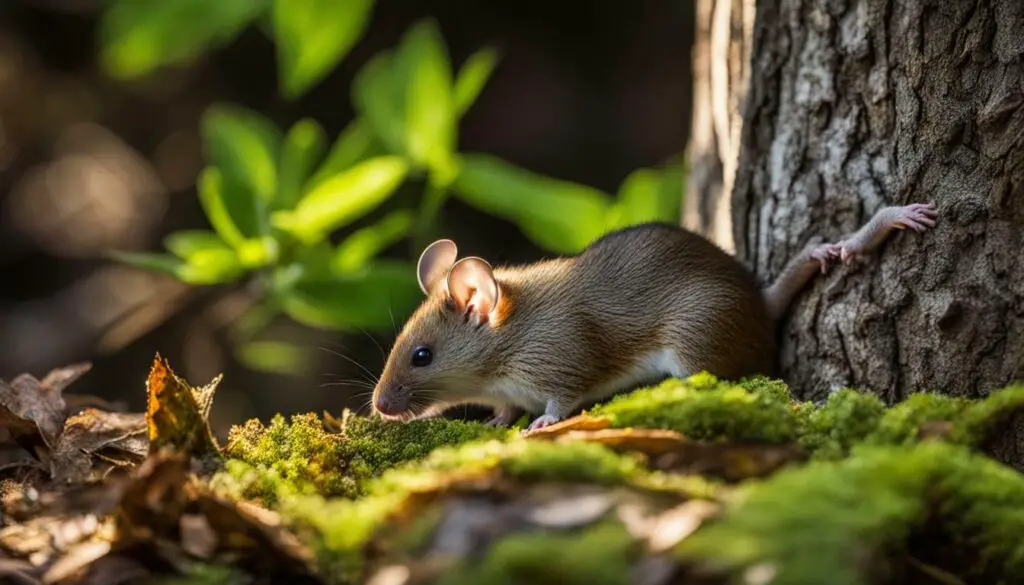
By adopting these preventive measures and seeking professional pest control services if needed, you can ensure the safety of your home and family. Remember to always handle deer mice and their droppings with caution to minimize the risk of disease transmission. With the right approach, you can successfully protect your property from the dangers posed by these nocturnal rodents.
Signs of a Deer Mouse Infestation
Identifying the signs of a deer mouse infestation is essential for effective control and prevention. These small rodents can be a nuisance and pose serious health risks, so it is important to be vigilant and take action if you suspect their presence in your home or building.
Common Indicators
One of the first signs to look out for is scurrying sounds. Deer mice are agile climbers and can quickly move through walls, attics, and crawl spaces, producing distinct noises as they search for food and shelter. If you hear scratching or running sounds, particularly at night, it may be an indication of a deer mouse infestation.
Another telltale sign is the presence of droppings. Deer mouse droppings are small, roughly the size of a grain of rice, and can accumulate in areas where the mice are active, such as behind furniture, in cabinets, or along baseboards. When cleaning up droppings, it is crucial to take precautions, such as wearing gloves and using disinfectant, to avoid potential exposure to harmful pathogens.
Gnaw marks and damaged materials are also indicators of a deer mouse infestation. These rodents have strong teeth and will chew on various objects to file down their constantly growing incisors. Look for gnaw marks on wires, insulation, wood, and other surfaces. Additionally, check for chewed openings in walls or gaps around pipes, as these can serve as entry points for deer mice.
Lastly, the presence of nests is a clear sign of an infestation. Deer mice construct nests using materials such as shredded paper, fabrics, and plant matter. These nests are often hidden in secluded areas, such as attics, basements, or storage spaces. If you come across a nest, it is crucial to handle it with care to minimize the risk of disease transmission.
Table: Signs of a Deer Mouse Infestation
| Signs of a Deer Mouse Infestation | Description |
|---|---|
| Scurrying sounds | Noise produced by deer mice as they move through walls and search for food and shelter. Mostly heard at night. |
| Droppings | Small, rice-sized droppings that accumulate in areas where deer mice are active. Take caution when cleaning them up. |
| Gnaw marks and damaged materials | Chewed surfaces on wires, insulation, wood, or other objects. Look for openings and gaps that serve as entry points. |
| Nests | Hidden nests made of shredded paper, fabrics, or plant matter. Take care when handling to minimize disease transmission. |
Being able to recognize these signs will help you take prompt action to address a deer mouse infestation. Remember, if you suspect an infestation, it is best to seek professional pest control services to ensure safe and effective removal of these rodents from your premises.
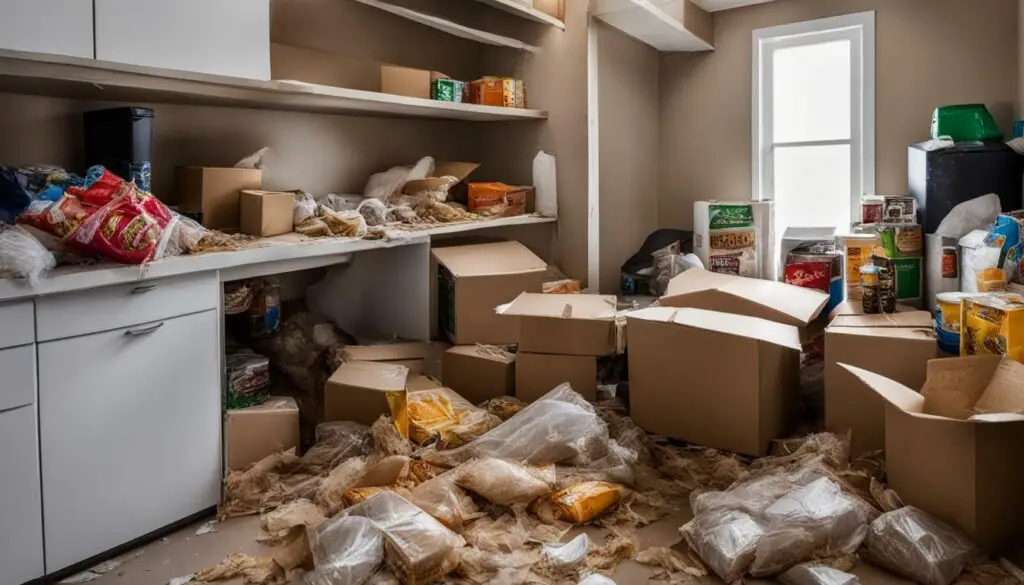
Taking preventive measures is crucial to avoid deer mouse infestations in your home. These rodents can carry dangerous diseases and cause significant structural damage if left unchecked. By implementing the following preventive strategies, you can minimize the risk of a deer mouse infestation and ensure the safety of your household.
Sealing Openings and Gaps
Deer mice can enter your home through small openings and gaps in the foundation, walls, or roof. Inspect your home thoroughly and seal any potential entry points to deny them access. Use caulk or steel wool to fill in cracks, gaps around pipes, and spaces around windows and doors. Pay close attention to areas where utility lines enter your home, as mice can squeeze through tiny openings.
Using Traps and Rodent Control Products
To catch and remove deer mice, set up snap traps or live traps in areas where you suspect their presence, such as along walls, in attics, or near food sources. Bait the traps with peanut butter or seeds to attract the mice. For added effectiveness, consider using rodent control products like ultrasonic devices or repellents that emit odors repugnant to mice, deterring them from entering your home.
Seeking Professional Pest Control Services
If you’re dealing with a persistent or extensive deer mouse infestation, it’s best to seek professional pest control services. Pest control experts have the knowledge, experience, and tools to safely and effectively remove these rodents from your property. They can also provide guidance on long-term prevention strategies to keep your home deer mouse-free.
| Preventive Measures | Benefits |
|---|---|
| Sealing openings and gaps | Prevents deer mice from entering your home |
| Using traps and rodent control products | Allows for the capture and removal of deer mice |
| Seeking professional pest control services | Ensures safe and effective removal of deer mice |
By implementing these preventive measures, you can protect your home and family from the risks associated with deer mouse infestations. Remember to handle deer mice and their droppings with caution to avoid potential disease transmission. Stay vigilant and take prompt action at the first signs of a deer mouse infestation to ensure a pest-free living environment.
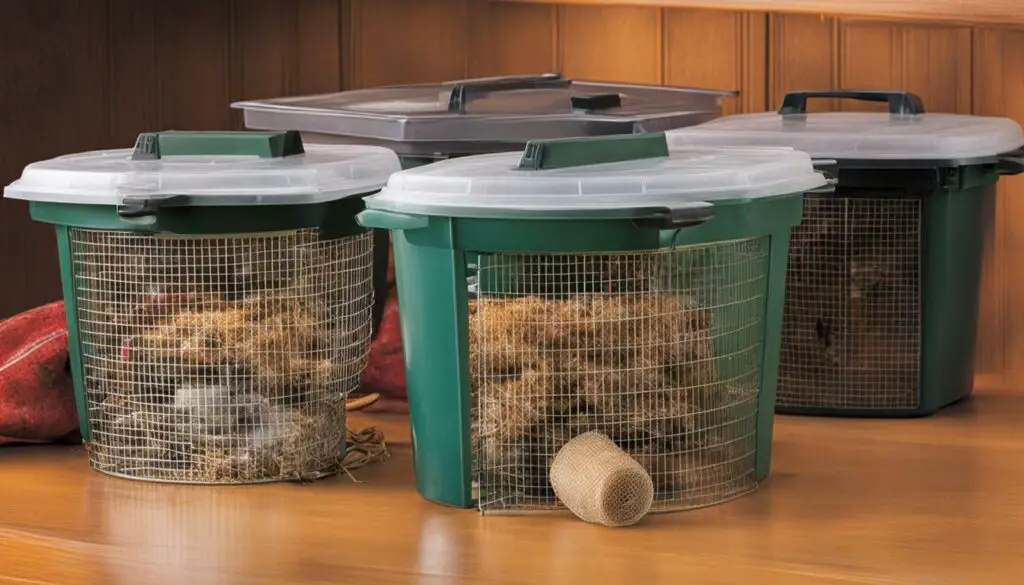
When facing a deer mouse infestation, it is highly recommended to seek professional pest control services. Deer mice are carriers of lethal diseases, such as the Hantavirus, and can cause severe structural damage to your home or building. Trying to handle the infestation on your own can put you and your family at risk. Professional pest control experts have the knowledge and experience to safely and effectively remove these rodents from your property.
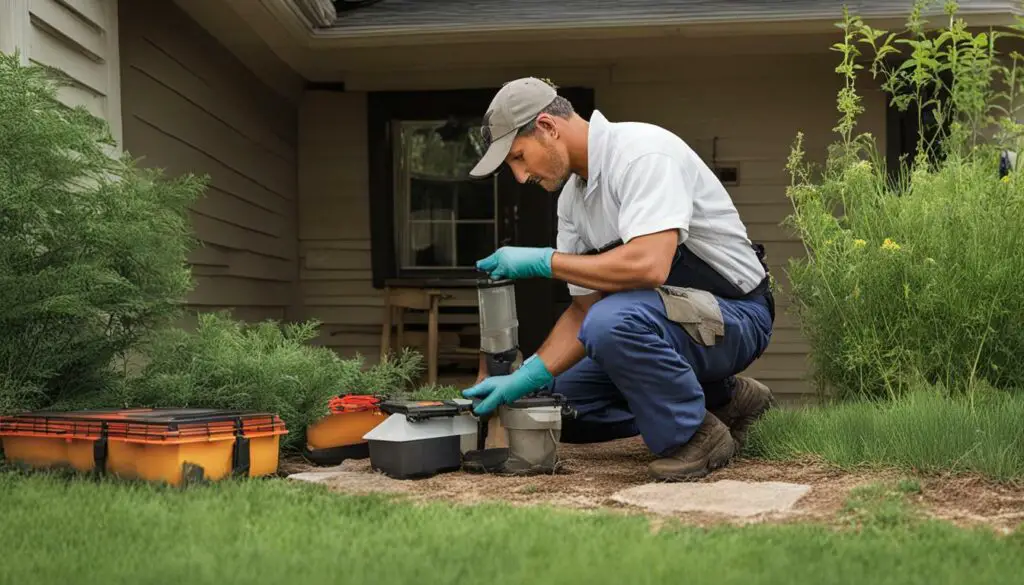
Professional wildlife control for deer mice involves a thorough assessment of the infestation, identifying entry points, and implementing targeted strategies for removal and prevention. Pest control technicians will use specialized tools and products to eliminate the deer mice and their nests, ensuring that they do not return.
In addition to removing the existing infestation, professional pest control services offer long-term solutions for deer mouse control. They will provide advice on sealing openings and gaps in your home or building to prevent future entry. They can also assist with ongoing rodent control strategies to maintain a pest-free environment.
| Benefits of Professional Pest Control for Deer Mice |
|---|
| Expert knowledge and experience in dealing with deer mice infestations. |
| Safe and effective removal of deer mice and their nests. |
| Identification and sealing of entry points to prevent future infestations. |
| Ongoing rodent control strategies to maintain a pest-free environment. |
Remember, deer mice can pose serious health risks and cause significant damage to your property. Don’t take chances with DIY solutions. Contact professional pest control services for expert assistance in dealing with deer mouse infestations.
Safe Handling and Disease Prevention
Handling deer mice and their droppings safely is vital to prevent the transmission of diseases. These small rodents can carry dangerous pathogens, including the Hantavirus, which can cause severe respiratory illness in humans. To protect yourself and your family, it’s important to take precautions when dealing with deer mice or cleaning up their droppings.
When cleaning areas where deer mice have been present, it is recommended to wear gloves, a mask, and protective clothing to minimize the risk of exposure to harmful particles. Avoid sweeping or vacuuming, as this can aerosolize the droppings and increase the chance of inhaling the virus. Instead, dampen the area with a disinfectant solution and carefully remove the droppings using disposable materials.
After handling deer mice or their droppings, thoroughly wash your hands with soap and warm water for at least 20 seconds. Avoid touching your face, especially your mouth, nose, and eyes, to prevent the transfer of any potential pathogens. Additionally, disinfect any surfaces or objects that may have come into contact with the rodents or their droppings.
Remember, if you suspect a deer mouse infestation or come into contact with these rodents, it’s best to consult a professional pest control service. They have the expertise and proper equipment to safely remove the mice and ensure your home is free from any potential health hazards. By taking these precautions and seeking professional help, you can protect yourself and your loved ones from the dangers associated with deer mice.
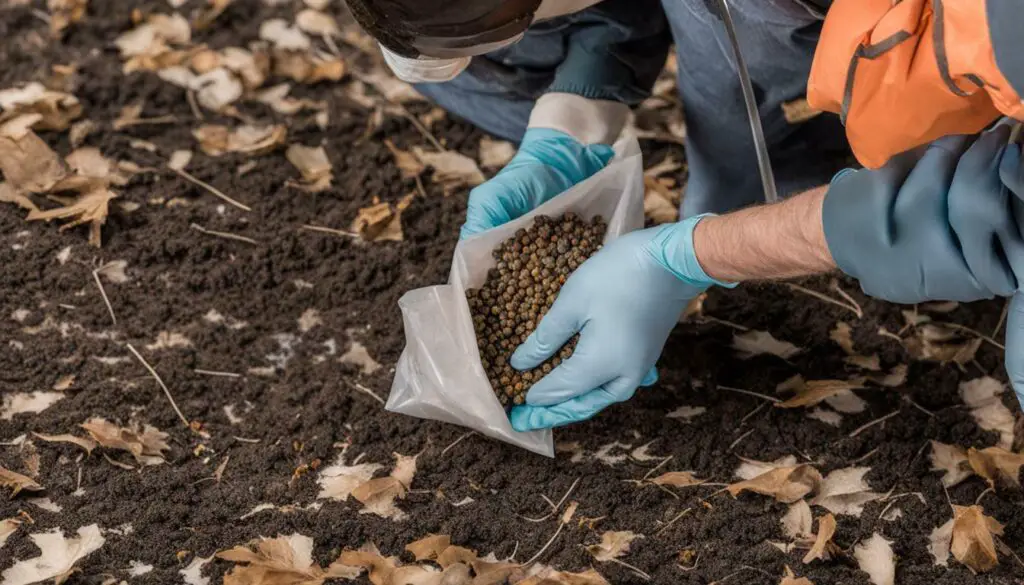
Implementing effective rodent control measures is key to long-term prevention of deer mice. These small rodents can wreak havoc on your home and pose serious health risks. To maintain a pest-free environment and protect your property and family, it is crucial to employ strategies that address the root causes of deer mouse infestation.
Start by sealing any openings and gaps in your home. Deer mice can squeeze through tiny cracks and holes, so take the time to inspect your property thoroughly. Use caulk or steel wool to seal off entry points, paying special attention to areas around pipes, vents, and utility lines.
Incorporating traps and rodent control products can also help manage deer mouse populations. Snap traps and glue boards are commonly used to catch these elusive creatures. Place traps along walls and in areas where you have noticed signs of activity, such as droppings or gnaw marks. Remember to check and dispose of trapped mice regularly.
Long-Term Solutions
For a more comprehensive approach to deer mouse control, consider implementing long-term solutions. This may involve removing potential food and water sources, such as bird feeders or leaking pipes, that could attract mice to your property. Keeping your home clean and clutter-free also reduces hiding places for deer mice.
Additionally, seeking professional pest control services can provide effective and efficient results. Pest control experts have the knowledge, experience, and tools necessary to identify and address deer mouse infestations. They can assess the extent of the problem, implement targeted treatments, and offer guidance on preventing future infestations.
| Effective Rodent Control Measures | Benefits |
|---|---|
| Sealing openings and gaps | Prevents mice from entering your home |
| Using traps and rodent control products | Captures and eliminates deer mice |
| Removing food and water sources | Deters mice from your property |
| Seeking professional pest control services | Expertise in effective removal and prevention |
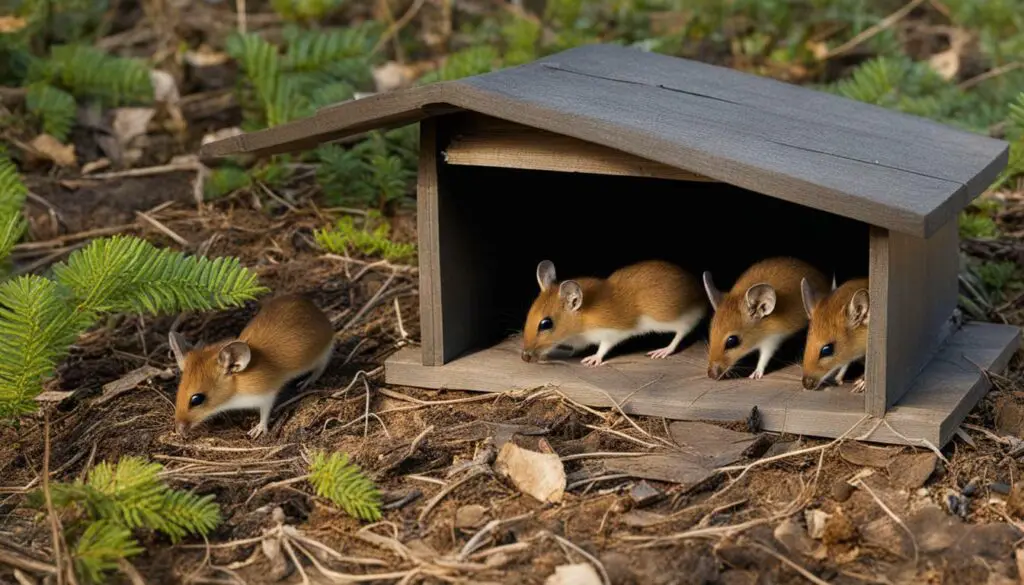
By implementing a combination of these rodent control measures, you can significantly reduce the risk of deer mouse infestation and the potential health hazards they bring. Stay vigilant, take prompt action at the first signs of an infestation, and create an environment that is inhospitable to these troublesome critters.
Conclusion
By understanding the risks and taking preventive measures, you can protect yourself and your home from the dangers of deer mice. These small rodents may seem harmless, but they are carriers of lethal diseases, including the Hantavirus, which can be transmitted to humans. It is crucial to be aware of the potential health hazards associated with deer mice and to take immediate action if you suspect an infestation.
Deer mice can also cause severe structural damage to homes and buildings. They have a knack for gnawing on wood, insulation, and electrical wiring, posing a significant risk of fires and costly repairs. Therefore, it is essential to address any signs of a deer mouse infestation promptly.
When it comes to their habits and habitat, deer mice are primarily nocturnal creatures. They are commonly found in forests, crops, and woodlands, but they may also venture into residential areas in search of food, water, and shelter. This increases the likelihood of them entering your home, posing a potential threat to your health and property.
To identify a deer mouse infestation, watch out for telltale signs such as scurrying sounds, droppings, gnaw marks, and nests. If you notice any of these indicators, it is crucial to take action immediately to prevent further damage and potential health risks.
Preventive measures are key to keeping your home deer mouse-free. Start by sealing openings and gaps in your home’s exterior, as these rodents can squeeze through even the tiniest cracks. Utilize traps and other rodent control products to catch and eliminate any invaders. In more severe cases, it is advisable to seek professional pest control services to ensure effective removal.
Remember, when handling deer mice and their droppings, use caution to avoid disease transmission. Wear gloves and a mask, and dispose of any contaminated materials properly. By being vigilant and implementing these preventive measures, you can safeguard your home and protect yourself and your loved ones from the risks of deer mice.
FAQ
Are deer mice dangerous?
Yes, deer mice are dangerous because they are carriers of lethal diseases, including the Hantavirus. They can also cause severe structural damage to homes and buildings.
Where can deer mice be found?
Deer mice can be found in forests, crops, and woodlands, but they may also enter homes in search of food, water, and shelter.
What are the signs of a deer mouse infestation?
Signs of a deer mouse infestation include scurrying sounds, droppings, gnaw marks, and nests.
How can I prevent deer mouse infestation?
You can prevent deer mouse infestation by sealing openings and gaps in your home, using traps and rodent control products, and seeking professional pest control services.
How should I handle deer mice and their droppings?
It is important to handle deer mice and their droppings with caution to avoid disease transmission. Take necessary safety precautions, such as wearing gloves and using proper cleaning techniques.

